 Like many things, the subways disappoint more often than not. The waits are too long, graffiti is creeping back again, the express won’t wait for passengers to cross the platform from the local, and token booth clerks, or rather station attendants, can bark more often than offer polite responses. A look at a 1967 report I recently inherited detailing all the spanking new lines to be built will create despair: only a partial one (the 63rd Street connector) was ever completed. And, there’s a strike every 20 years or so.
Like many things, the subways disappoint more often than not. The waits are too long, graffiti is creeping back again, the express won’t wait for passengers to cross the platform from the local, and token booth clerks, or rather station attendants, can bark more often than offer polite responses. A look at a 1967 report I recently inherited detailing all the spanking new lines to be built will create despair: only a partial one (the 63rd Street connector) was ever completed. And, there’s a strike every 20 years or so.
I love the trains just the same. The MTA and the NYPD don’t really return the affection, with photo bans, official or otherwise. Unlike most railfans, however, the trains themselves for me are only a sidebar to the main attraction: station signage and design. Though more recently built stations are old enough to be recognized as historical artifacts in their own right, subway design reached its apotheosis in the original 28 subway stations, designed by architects George Heins and Christopher LaFarge, engineered and built by William Barclay Parsons and opened to the public on October 27, 1904. The original line ran from City Hall to 145th Street and is now a part of today’s #6 line, Times Square-Grand Central Shuttle, and #1 line.
City Hall station is tiny compared with other NYC subway stations, has only one platform, and has been devilishly difficult to enter since December 31st, 1945. New, lengthier subway cars then entering the system fleet made the station a liability: its sharply curved platform made for lengthy gaps when the new cars’ doors were opened.
City Hall station is the most beautiful of NYC’s unknown rail relics.
 Postcard of City Hall station shortly after its October 27, 1904 opening. from collection of Ed Levine
Postcard of City Hall station shortly after its October 27, 1904 opening. from collection of Ed Levine
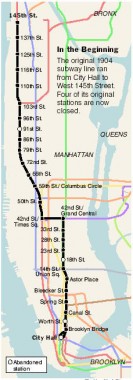 New York Times map of original subway, 1904.
New York Times map of original subway, 1904.
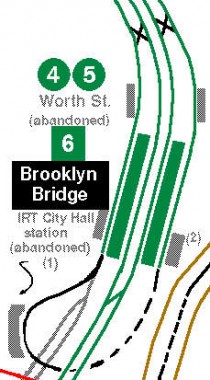 Track map of City Hall, Brooklyn Bridge and Worth Street.track map: Peter Dougherty
Track map of City Hall, Brooklyn Bridge and Worth Street.track map: Peter Dougherty
 Heins and LaFarge used a special tiling, color, and typography scheme at City Hall used nowhere else in the system, employingRafael Guastavino’s interlocking tile styling. Green and white ceramic tiles dominate the station though blue and gold are occasionally present. photo: Jake Dobkin
Heins and LaFarge used a special tiling, color, and typography scheme at City Hall used nowhere else in the system, employingRafael Guastavino’s interlocking tile styling. Green and white ceramic tiles dominate the station though blue and gold are occasionally present. photo: Jake Dobkin
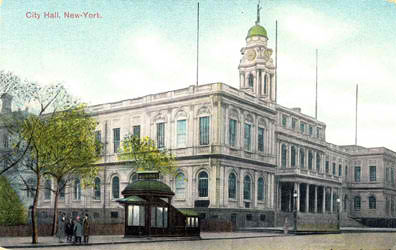 City Hall station was accessed by a cast-iron kiosk on a driveway almost directly in front of City Hall, built at what was the northern end of town in 1812. All original subway stations sported these entrance kiosks (and a differently designed exit kiosks) but at length, they came to be pedestrian and traffic impediments, and all were gone by 1960. A reconstructed one can be found at Astor Place (see below). from collection of Ed Levine
City Hall station was accessed by a cast-iron kiosk on a driveway almost directly in front of City Hall, built at what was the northern end of town in 1812. All original subway stations sported these entrance kiosks (and a differently designed exit kiosks) but at length, they came to be pedestrian and traffic impediments, and all were gone by 1960. A reconstructed one can be found at Astor Place (see below). from collection of Ed Levine
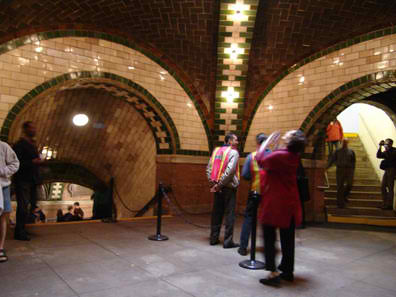 Passengers arrived at the lobby level one floor below, with stairways to the track platforms (left) and back to the street (right). Tickets would be purchased from a wood booth on this level.photo: Richard Panse
Passengers arrived at the lobby level one floor below, with stairways to the track platforms (left) and back to the street (right). Tickets would be purchased from a wood booth on this level.photo: Richard Panse
If passengers happened to look toward the lobby roof they would have seen a beautiful circular skylight surrounded by eight lights. In 1904, commercial electric illumination was just about a decade old. The City Hall station skylights are made of cut amethyst glass. A renovation for the subway centennial in 2004 erased decades of grime (the skylights were blackened during WWII) and allowed sunlight to once again shine in the station. photo left: Peter Dougherty; photo right: Mike Epstein
The station name plaques use techniques and colors seen nowhere else in the system, like the gold tiles and aqua borders and type seen here.
RIGHT: a second view of the vault, Guastavino tiling and skylight. photo: Jake Dobkin
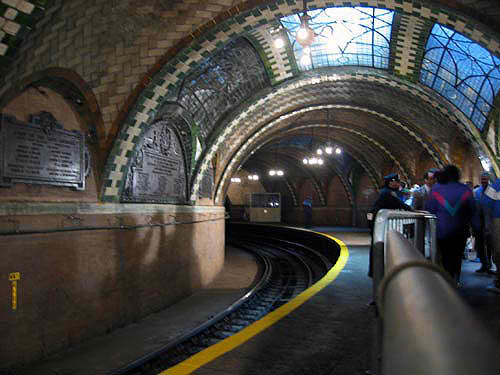 City Hall station, October 2004, 100 years after opening. This gives a good indication on how much the skylights lit the station. In another feature totally unique in NYC’s subways, metal chandeliers are suspended from the ceiling.photo: Mike Epstein
City Hall station, October 2004, 100 years after opening. This gives a good indication on how much the skylights lit the station. In another feature totally unique in NYC’s subways, metal chandeliers are suspended from the ceiling.photo: Mike Epstein
Brass plaques, commemorating the station’s opening, are located on the walls opposite the station platform.
nycsubway.org at City Hall
Joe Brennan in Abandoned Stations
Forgotten NY’s 1998 visit
Brooklyn Bridge
Brooklyn Bridge is now the southern terminal for the Lexington Avenue local (City Hall was until 1945, and locals still loop around the trackways past the station to begin the northbound run). As we’ll see, a northern extension was built that made the next station to the north unnecessary.
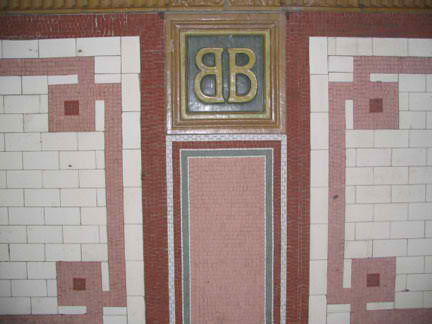 Not much of Brooklyn Bridge’s original ceramic work is still in public areas. This is because the station was built with local platforms that have been closed since as early as 1910. This distinctive “BB” plaque, and unusual salmon-colored tiling, is near the Municipal Building entrance. It was produced by the Grueby Faience Compnay of Boston: “Faience” is a ceramic that differs from terra cotta in that it is double-fired for greater opacity and color brilliance.
Not much of Brooklyn Bridge’s original ceramic work is still in public areas. This is because the station was built with local platforms that have been closed since as early as 1910. This distinctive “BB” plaque, and unusual salmon-colored tiling, is near the Municipal Building entrance. It was produced by the Grueby Faience Compnay of Boston: “Faience” is a ceramic that differs from terra cotta in that it is double-fired for greater opacity and color brilliance.
NYCsubway.org at Brooklyn Bridge
Joe Brennan makes discoveries behind the wall
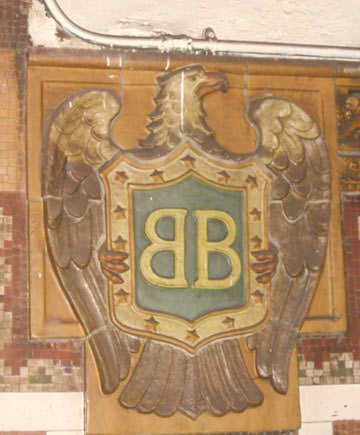 The occasional Transit Museum tour that plumbs behind the walls that shield the abandoned side platforms reveals a couple of Grueby ceramic station eagles…which are at only three stations in the subway. The eagle wears an annoyed expression and his shield has 14 stars where you might expect 13.
The occasional Transit Museum tour that plumbs behind the walls that shield the abandoned side platforms reveals a couple of Grueby ceramic station eagles…which are at only three stations in the subway. The eagle wears an annoyed expression and his shield has 14 stars where you might expect 13.
Early IRT express stations were built with both island (express) platforms and side (local) platforms. It was thought that because of heavy passenger traffic, local and express “customers” should be kept apart from each other. Eventually this notion was dropped — except at both the IND and 7th Avenue IRT 34th Street stations, both constructed after Penn Station had been built. The architects predicted huge crowds at these stations, and so side platforms were built — making it quite inconvenient to change from express to local service at each to this day.
 Worth Street was named for Gen. William Jenkins Worth, a hero of the Mexican War in the 1840s. The general is buried at his monument at the triangle formed by 5th Avenue, Broadway and West 25th Street. Worth Street, an important east-west cross street, earned its own station on the original subway in 1904. It was closed in 1962 when the Brooklyn Bridge station was extended north.Joe Brennan at Worth Street (includes good views of the station’s ID shields and name tablets)
Worth Street was named for Gen. William Jenkins Worth, a hero of the Mexican War in the 1840s. The general is buried at his monument at the triangle formed by 5th Avenue, Broadway and West 25th Street. Worth Street, an important east-west cross street, earned its own station on the original subway in 1904. It was closed in 1962 when the Brooklyn Bridge station was extended north.Joe Brennan at Worth Street (includes good views of the station’s ID shields and name tablets)
 Canal Street is named for a 19th-century canal created to drain Collect Pond, which was in the present Foley Square area. The originally freshwater pond was used by early colonists as a refuse and offal dump, and by the early 1800s it had become a stinking miasma. Eventually the canal had served its purpose and Canal Street was built on its old route. It has become a main truck route and a mecca for discount stores.
Canal Street is named for a 19th-century canal created to drain Collect Pond, which was in the present Foley Square area. The originally freshwater pond was used by early colonists as a refuse and offal dump, and by the early 1800s it had become a stinking miasma. Eventually the canal had served its purpose and Canal Street was built on its old route. It has become a main truck route and a mecca for discount stores.
There are no less than six NYC Canal Street subway stations: IRT 7th Avenue (#1) at Varick, IND 8th Avenue (A, C, E) at 6th Avenue, BMT Broadway express and local (J, M, Z), BMT Nassau Street line at Centre Street, and the very first, built here in 1904 at Canal and Centre Streets, served by the #6.
Though Canal Street has a couple of layers of renovations from various decades, a few original elements remain. The station sports a green scheme overall. As this picture shows, the original subway was built just below the street, allowing sun to pour in from skylights that were part of the station design. They were blocked up long ago, though at certain stations the sun streams in from breaks in the sidewalk.
The Canal Street station cartouche (right) like others in neighboring stations, was originally fired by the Atlantic Terra Cotta Company in Staten Island (in fact, a small stop on the Staten Island Railway is named Atlantic, since the factory was nearby). After 100 years the finish on these cartouches still shines. The “C” on the cartouche is accompanied by two poppy flowers.
The 1904 stations were quite short. At the beginning, trainsets were only a couple of cars long, so at present, original station artwork takes up only a small area in the modern-day station. Later subway architects who took up the mantle from Heins and LaFarge such asSquire Vickers applied an Arts and Crafts sensibility, with mosaic plaques depicting area histories, to subway stations he designed. The extension at Canal Street, though, finds him exploring a more streamlined side that he would fully employ in the IND, built in the Machine Age, ushered in by the 1925 Paris Exposition.
 The second consecutive station named for a body of water, Spring Street is named for a formerly freshwater spring that is now buried in the sewers under several layers of pavement.
The second consecutive station named for a body of water, Spring Street is named for a formerly freshwater spring that is now buried in the sewers under several layers of pavement.
Spring Street station is built along a very gentle curve on Lafayette Street (so gentle in fact that it’s not seen on street maps). The original station tablet features the mosaic bellflower theme used on similar stations built about this time. In recent years, the MTA has repainted station columns in a solid color topped by a stripe, which was the original 1904 scheme, though we don’t know whether blue and gold were the actual colors then.
The station moldings are painted beige and feature flowering plants. The “S” cartouches differ very slightly from the ones at Canal Street. There are two poppies again, but the leaves are different and the whole plaque is a little deeper.
Bleecker, often misspelled without its “c”, was named for William Bleecker, a friend of Washington Irving and William Cullen Bryant, who was a writer himself: a renowned punster, his work appeared in several publications in the 1810s and 1820s. Bleecker Street runs through his former property. Along with Houston, it’s the only named street that extends from the West Village to the East Village.
The highlights of Bleecker Street station are unquestionably the brilliant blue Grueby Faience station ID plaques (and this was the case even in 1905, a year after the station opened, as we see a passenger regarding one in the postcard at right (courtesy of Ed Levine). Each plaque is built from 27 pieces of faience ceramic. While the plaques show poppies..
…the cartouches show tulips, apropos in a city with Dutch origins. Bleecker Street cartouches are in bad condition and await restoration.
When station names appear on columns, occasional unusual abbreviations have to be used.
The later Vickers station tablets, with even later ones from the IND era. Even these are complex in their own way, with 5 different colors employed.
 John Jacob Astor, né Ashdor, was the richest man in the United States for a time in the early 1800s. He was originally a dealer of musical instruments as a young man in Walldorf, Germany but while enroute to Baltimore in 1783 he was told about the fur trade in America and set up shop on Water Street downtown, and subsequently made $30 million. The Waldorf-Astoria Hotel remembers both Astor and his hometown, as does Astoria, Queens, a town he never entered, andAstoria, Oregon, where he sent fur traders in 1811.
John Jacob Astor, né Ashdor, was the richest man in the United States for a time in the early 1800s. He was originally a dealer of musical instruments as a young man in Walldorf, Germany but while enroute to Baltimore in 1783 he was told about the fur trade in America and set up shop on Water Street downtown, and subsequently made $30 million. The Waldorf-Astoria Hotel remembers both Astor and his hometown, as does Astoria, Queens, a town he never entered, andAstoria, Oregon, where he sent fur traders in 1811.
From the start Astor Place station has been connected directly to buildings above it. The 1905 postcard shows the connection toWanamaker’s, now housing a K-Mart, while a bricked-up door leads to the former Clinton Hall.
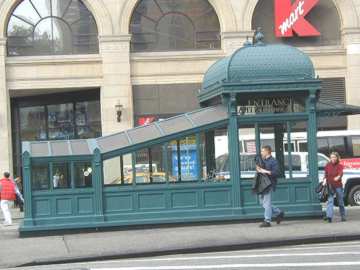 All original entrance and exit kiosks are now gone, but as part of station renovations in the 1980s, a cast was made that approximates the appearance of the former ones in the island at Cooper Square and Astor Place.
All original entrance and exit kiosks are now gone, but as part of station renovations in the 1980s, a cast was made that approximates the appearance of the former ones in the island at Cooper Square and Astor Place.
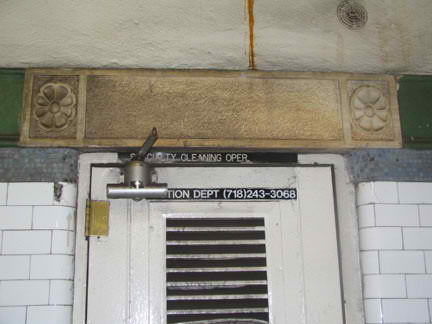 In many original stations, doors are topped by stone flowers.
In many original stations, doors are topped by stone flowers.
The beavers whose pelts made Astor rich are depicted in the station by Grueby. This is the first station on the line in which a graphic element of this type was executed: there would be many more in the IRT and continuing on new BMT construction on into the 1920s. While later stations would use mosaics, though, here faience was used, and you can see what we meant by rich color. The beaver, resting on a tree stump and gnawing on a trunk, is surrounded by the bellflower motif and also by the precise geometric shapes, squares and diamonds, that are also a hallmark of original subway stations: the diamond surrounded by four squares is repeated at other stations further up the line. At 22.5×14 inches these plaques are the largest in the system (excluding station name plaques), and the ten-inch borders give them added size.
Astor Place utilizes two species of columns: the original cylindrical ones employing a restored original paint scheme, and also columns surrounded by load-bearing brick. Such columns are mostly used where a station passes under a building.
 Though it’s always been a local station Astor Place was considered important enough by Heins and LaFarge to receive a large ceramic faience identification plaque. These were used only at Astor Place and as we’ll see, 28th Street, 50th Street, Columbus Circle and 66th Street.
Though it’s always been a local station Astor Place was considered important enough by Heins and LaFarge to receive a large ceramic faience identification plaque. These were used only at Astor Place and as we’ll see, 28th Street, 50th Street, Columbus Circle and 66th Street.
The font looks like the kind of thing master typographer Frederic Goudy was working on at about this time (such as Hadriano), though his involvement is unlikely.
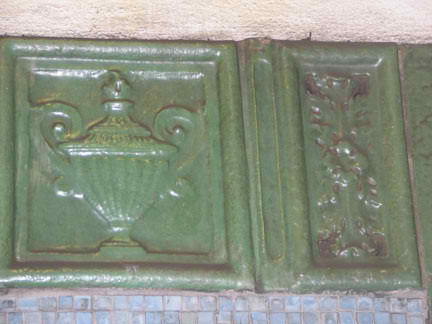 The Grecian urn (or is it a lamp? I’m not sure) was also a favorite Heins and LaFarge motif. It was introduced here at Astor Place and will be seen at other uptown stations as well.
The Grecian urn (or is it a lamp? I’m not sure) was also a favorite Heins and LaFarge motif. It was introduced here at Astor Place and will be seen at other uptown stations as well.
Even subway grills and metalwork are carefully planned, and well into the IND years, distinctive grillwork is a subway highlight.
RIGHT: cartouches and signage echo the typefont we have seen on the faience plaque (above.) They are 1980s elements designed to echo original appointments.
 A question that has dogged me for some time is the genesis of New York City’s main numbered crosstown streets. They are 14, 23, 34, 42, 57, 72, 86, 96, 106, 110, 116, 125, 135, 145, 155; things get a little muddled after that, with 181 and 207 being wide cross streets. To me, the numbers hardly make sense as to why these streets were chosen to be Manhattan’s widest and most trafficked streets. Since we have 10 fingers and 10 toes we tend to divide things in fives and tens. Wouldn’t it be natural to evenly space out main streets at 10, 15, 20, 25 etc.?
A question that has dogged me for some time is the genesis of New York City’s main numbered crosstown streets. They are 14, 23, 34, 42, 57, 72, 86, 96, 106, 110, 116, 125, 135, 145, 155; things get a little muddled after that, with 181 and 207 being wide cross streets. To me, the numbers hardly make sense as to why these streets were chosen to be Manhattan’s widest and most trafficked streets. Since we have 10 fingers and 10 toes we tend to divide things in fives and tens. Wouldn’t it be natural to evenly space out main streets at 10, 15, 20, 25 etc.?
The numbers seem to keep to no discernible pattern. They occur, in order, 9, 11, 8, 14, 15, and 14 blocks apart (excepted by 59th, which is the southern end of Central Park) until we reach 86th Street, when a 10-block separation begins (excepted by 110th, which is the northern end of Central Park). Beginning with 125th, main cross streets commence a more “logical” sequence, appearing every ten blocks.
I have been thinking that main cross streets occur where Broadway (which runs athwart Manhattan’s orderly grid) intersects a north-south avenue. Broadway, more or less, reaches 4th Avenue at 14th Street, but not quite exactly; Union Square was named for a group of colonial roads that met there in the early 19th Century. Broadway reaches 5th at about 23rd, but not quite; the junction actually happens at 24th, a block north. Broadway’s junction with 6th Avenue occurs at just about 34th, but not precisely. By the time Broadway reaches 7th Avenue the two roads are almost parallel; Broadway has to take up a few blocks crossing 7th, and it doesn’t do it at 42nd, but rather between 44th and 46th, Times Square. Broadway reaches 8th Avenue at about 59th, but has to make a rather sharp turn in the upper 50s since it still parallels 7th through much of the 50s. Broadway gets to 9th (Columbus) at 65th Street, which has never been a main street, and gets to 10th (Amsterdam) at 72nd. North of there, Broadway has a straight run, more or less, up to 103rd Street (which, not coincidentally, is where subway engineers decided to build a branch off the original route to the Bronx in 1905).
Originally, when it was the Bloomingdale Road, Broadway did a lot of twisting and turning to the west of where Central Park would be, but as the park was built and cross streets were laid out, it was thought best to straighten Broadway and so it was, beginning in the 1870s.
If any NYC historian can clear up this business about the numbers, let me know.
Where was I? Ah, the 14th Street subway station.
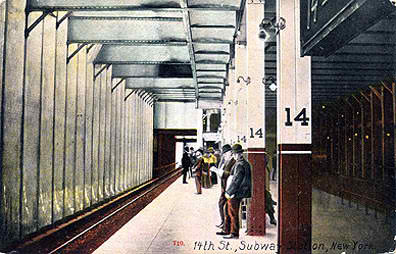 Of “the original 28,” 14th, 23rd and 42nd have been altered the most, with a lot of changes from the 1904 opening date. Fulfilling Union Square’s name, the original 14th Street station has been joined by two other subway lines, the Broadway BMT in 1915 and the BMT 14th Street crosstown line in 1928, making this station one of Manhattan’s most complex (probably second only to Times Square in that regard). Since it’s built on a sharp curve, 14th Street joins South Ferry as one of two stations with mechanical movable platforms that fill the large gaps between the cars and the platforms. The 14th Street “gap fillers” were added as early as 1914 and relocated in 1955 (local) and 1962 (express).
Of “the original 28,” 14th, 23rd and 42nd have been altered the most, with a lot of changes from the 1904 opening date. Fulfilling Union Square’s name, the original 14th Street station has been joined by two other subway lines, the Broadway BMT in 1915 and the BMT 14th Street crosstown line in 1928, making this station one of Manhattan’s most complex (probably second only to Times Square in that regard). Since it’s built on a sharp curve, 14th Street joins South Ferry as one of two stations with mechanical movable platforms that fill the large gaps between the cars and the platforms. The 14th Street “gap fillers” were added as early as 1914 and relocated in 1955 (local) and 1962 (express).
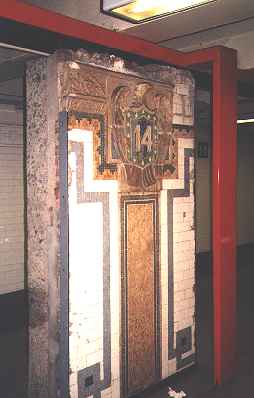 Like Brooklyn Bridge and 96th Street, 14th Street has a pair of abandoned side platforms that are mostly covered by a wall and sets of grills, though some of the platform pokes out in spots.
Like Brooklyn Bridge and 96th Street, 14th Street has a pair of abandoned side platforms that are mostly covered by a wall and sets of grills, though some of the platform pokes out in spots.
Fortunately, some of the artwork from the side platforms, including eagle plaques, has been preserved along with some of the station walls, as a 1998 art installation by Mary Miss (Miss Miss to you) entiled Framing Union Square.
Elsewhere in the station, new porcelain station plaques have been installed in the spirit of the old, and original mosaics poke through in some spots, though cleverly “framed.”
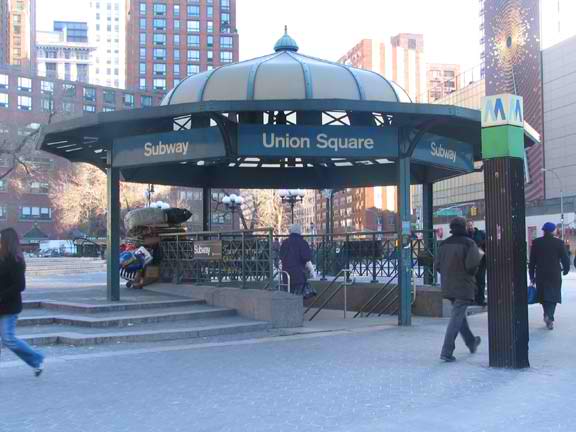 A modern station kiosk has been installed over the main entrance in Union Square Park. It is ingeniously designed with an onion-dome shape, like the kiosks of old. Note the 1970s-style MTA pylon next to it, with the discontinued MTA logo.
A modern station kiosk has been installed over the main entrance in Union Square Park. It is ingeniously designed with an onion-dome shape, like the kiosks of old. Note the 1970s-style MTA pylon next to it, with the discontinued MTA logo.
 A block away from the 18th Street station on Park Avenue South, on Irving Place, you’ll find Pete’s Tavern, an old O. Henry hangout, as well as NYC’s only twin bishop’s crook lamppost. Further west, 18th is the epicenter of the Ladies’ Mile department store region on 6th Avenue, with the massive Siegel-Cooper Building. Traveling even further west you encounter Movie Star News, founded by Irving Klaw, who can be forever thanked for bringing the world Bettie Page.
A block away from the 18th Street station on Park Avenue South, on Irving Place, you’ll find Pete’s Tavern, an old O. Henry hangout, as well as NYC’s only twin bishop’s crook lamppost. Further west, 18th is the epicenter of the Ladies’ Mile department store region on 6th Avenue, with the massive Siegel-Cooper Building. Traveling even further west you encounter Movie Star News, founded by Irving Klaw, who can be forever thanked for bringing the world Bettie Page.
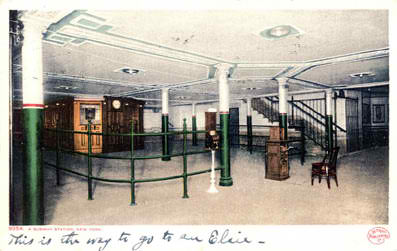 18th Street station in 1904. card from the collection of Ed Levine
18th Street station in 1904. card from the collection of Ed Levine
Looking out the window of the #6 local as it travels uptown or downtown you will see the remains of the 18th Street station, which went out of business in 1948 when the 14th Street station was extended north. The 7th Avenue IRT extension from the 1910s has retained its 18th Street station.
NYCSubway.org at 18th Street
Joe Brennan discusses 18th Street
 So, you’ve probably heard the explanation of how the old expression, “23 skiddoo” came about. The construction of the Flatiron Building at Madison Square in 1905 made for some wicked breezes due to the building’s triangular shape, and soon enough it attracted young men looking for a shocking glimpse of stocking as the wind lifted up women’s skirts. Policemen would yell, “23 skiddoo” at the oglers to make them scatter. I don’t know; for me the story lacks a certain veracity. Why would you yell a street number at someone to make them move? If you were a cop, wouldn’t you say, “move along, bud?” Well, this is an era that produced expressions like “I love my wife, but oh, you kid,” so you never know.
So, you’ve probably heard the explanation of how the old expression, “23 skiddoo” came about. The construction of the Flatiron Building at Madison Square in 1905 made for some wicked breezes due to the building’s triangular shape, and soon enough it attracted young men looking for a shocking glimpse of stocking as the wind lifted up women’s skirts. Policemen would yell, “23 skiddoo” at the oglers to make them scatter. I don’t know; for me the story lacks a certain veracity. Why would you yell a street number at someone to make them move? If you were a cop, wouldn’t you say, “move along, bud?” Well, this is an era that produced expressions like “I love my wife, but oh, you kid,” so you never know.
Forgotten Fan William Hohauser has heard a different story:
“The term came from a time when 23rd street was a major party street with lots of theaters and drinking establishments, 1890’s maybe. Due to the “Blue” laws of the time, the bars and pubs had to close at a much earlier time then they do now. Naturally people were not quite ready to stop drinking and carousing when the law told them to. “23 Skiddoo” supposedly is the name given to the mass chaos that occurred as the bars closed and everyone rushed to find a ride to an illegal speakeasy or a private party. After the mass exodus the street would
turn dark and empty.”
23rd and the couple blocks north of it make up NYC’s Toy District in the region near Madison Square.
23rd Street has been nearly completely renovated, with the glazed vertical beige bricks seen at photo right, adjacent to some of the little original artwork left, a floor to ceiling tapestry with the usual mosaic bellflowers. Above we see a brown and beige name tablet from a later platform extension above IND-type directional arrows.
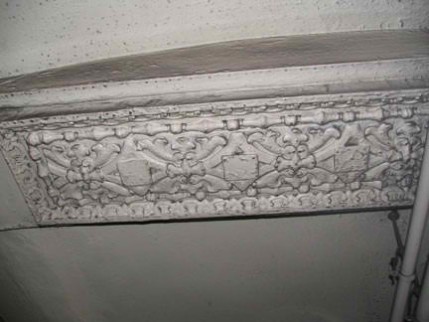 LEFT: ornate ceiling moldings. Older IRT stations can be recognized by them since later ceilings were left plain.
LEFT: ornate ceiling moldings. Older IRT stations can be recognized by them since later ceilings were left plain.
As Jim Naureckas reports in New York Songlines, Robert Shaw commanded NYC cops to deliver a $1 million ransom for a hijacked subway car in the 1974 thriller The Taking of Pelham 1-2-3 at the 28th Street station. The station also was home to the system’s first robbery on opening day. It would not be the last. 28th was home to New York’s Tin Pan Alley, where songwriters and song pluggers played and sold tunes to prospective customers; the street is now the epicenter of NYC’s Flower District between 6th and 7th Avenues, and also home to clothing wholesalers and further west, forms the northern boundary to a small neighborhood home to sewing machine wholesalers and showroom dummy manufacturers. Perhaps they come to life at night, like in the Twilight Zone.
Who knows why Heins and LaFarge decided to place a large Grueby Faience station name tablet in the 28th Street station…it’s a local stop, not a major stop by any means (Bleecker Street never was either). Note that the typefont is the same one used at Astor Place. When one of them was lost at some time in the past, it was decided to replace it with a truly hideous mosaic copy: dig the dated “computery” typefont they used for it. The tiled flowers were painstakingly done, and interesting enough.
28th Street also features some Atlantic Terra Cotta cartouches. The station extension mosiac adheres to the overall blue and gold station color scheme.
The wall bases are described as “buff Norman brick” in The New York Subway: Its Construction and Equipment, the first book published about the new subway by the Interborough Rapid Transit Company (the IRT) in 1904. It was reprinted by Fordham University Press in 2004, the subway’s centennial. At right we see a blocked up station crossunder.
 Not a major station on the original IRT (it may have been had it been built closer to Macy’s, which moved to Herald Square in 1902), but when subsequent BMT and IND lines were built, as well as a southern IRT extension, Penn Station had been constructed and so, two consecutive stations, 34th and 42nd, became important transfer points. Have you ever heard anyone prounouce this “Toidy-toid”? I haven’t. A New York accent definitely exists: it consists mainly of pronouncing “ar” as “ah”–but the practice of making “ir” into “oi” and vice-versa is definitely dying out and can be heard pretty much these days as Mel Blanc voiced Bugs Bunny (Bugs is a NYer — check “A Hare Grows in Manhattan” for the story). On 33rd you will find the Cheyenne Diner, B&H Photo (both at 9th Avenue), Madison Square Garden and Penn Station (at 7th), Hotel Pennsylvania (where the phone number is PEnnsylvania 6-5000), the Manhattan Mall (formerly Gimbel’s), Little Korea, and the Empire State Building…not bad…
Not a major station on the original IRT (it may have been had it been built closer to Macy’s, which moved to Herald Square in 1902), but when subsequent BMT and IND lines were built, as well as a southern IRT extension, Penn Station had been constructed and so, two consecutive stations, 34th and 42nd, became important transfer points. Have you ever heard anyone prounouce this “Toidy-toid”? I haven’t. A New York accent definitely exists: it consists mainly of pronouncing “ar” as “ah”–but the practice of making “ir” into “oi” and vice-versa is definitely dying out and can be heard pretty much these days as Mel Blanc voiced Bugs Bunny (Bugs is a NYer — check “A Hare Grows in Manhattan” for the story). On 33rd you will find the Cheyenne Diner, B&H Photo (both at 9th Avenue), Madison Square Garden and Penn Station (at 7th), Hotel Pennsylvania (where the phone number is PEnnsylvania 6-5000), the Manhattan Mall (formerly Gimbel’s), Little Korea, and the Empire State Building…not bad…
33rd Street station was built at the former site of the 71st Regiment Armory, which was completed a year after the subway arrived. This was actually the second armory on the site: an earlier one built in 1892 burned down 10 years later. The site is now occupied by the 42-story 3 Park Avenue building.
For a building that’s been gone for several years, the Armory is remembered in several ways here. Its original plaque has been attached to 3 Park Avenue, and its old retaining wall makes up part of the Park Avenue subway entrance.
It’s also been said that faience and mosaic eagles in stations indicate that armories were located above the stations, but that’s only true here at 33rd Street. At Brooklyn Bridge and 14th Street, as we’ve sen, no such armories existed. Notice the swastika pattern on the faience plaque. It’s innocent in origin: the German national Socialist Party wouldn’t adopt it as a symbol until the 1920s, and before that, it was simply a symbol of good fortune. In fact it’s here likely as a conequence of the artowrk pattern and isn’t intentionally a swastika pattern at all. We will also see this further north on the Original 28.
James Garvey’s Lariat Seat Loops, brass fixtures installed at the columns, works perfectly well as station seating.
33rd Street’s fare control ironwork is much different from that found at other stations, and likely goes back a few decades earlier. A station renovation in the 1990s left 33rd’s name tablets and faience eagles looking better than ever.
NEXT: The original 28 from 42nd to 145th Streets
SOURCES:
The New York Subway, Its Structure and Equipment, 1904 Centennial Edition, Fordham University Press 2004
BUY this book at Amazon.COM
Subway Ceramics, Lee Stookey, self-published 1994
BUY this book at Amazon.COM
Subway Style, The New York Transit Museum, Stewart, Tabori and Chang 2004
BUY this book at Amazon.COM
RELATED:
Photographs, for the most part, shot in January 2005 by your webmaster unless otherwise indicated. Page completed 1/2/06.

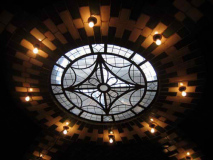
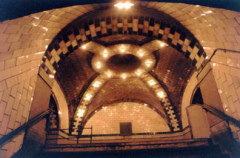
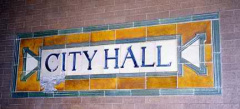
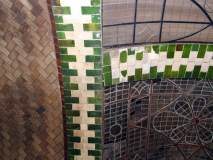
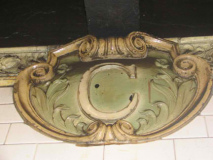
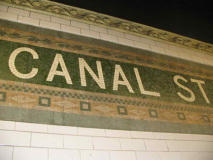
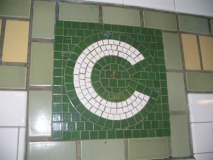
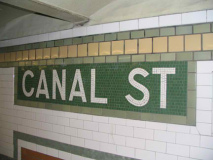
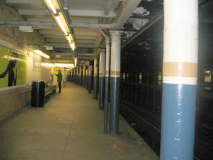
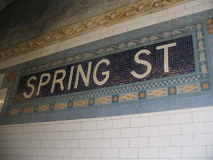
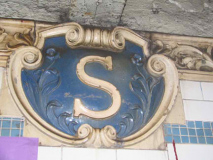
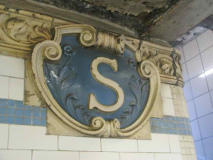

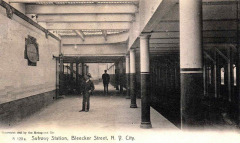
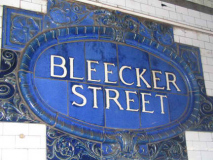
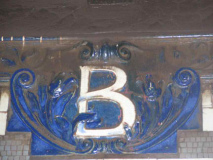
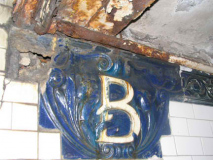
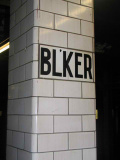
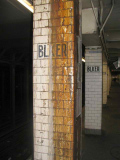
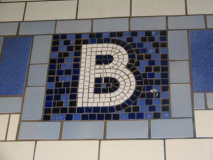
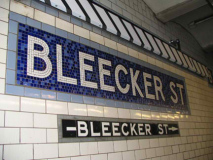
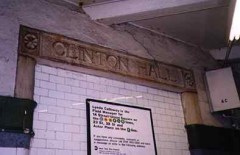

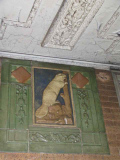
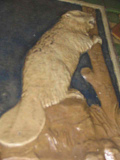
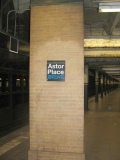
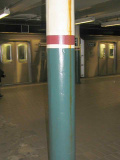
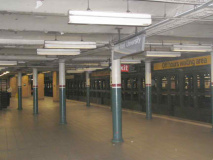
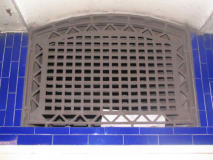
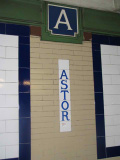
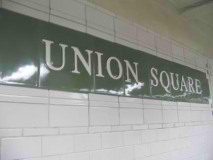
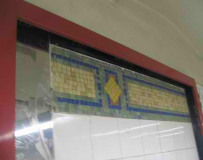
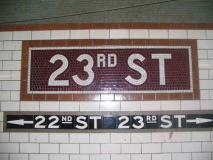
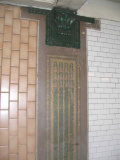


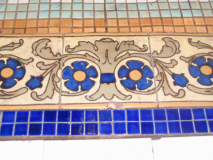
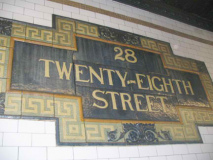
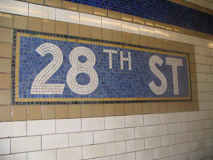
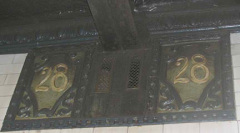
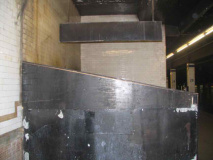
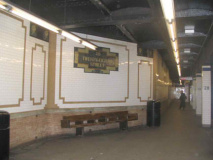
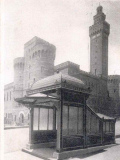
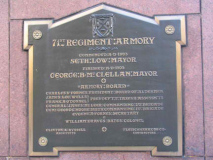
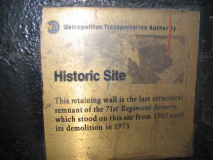
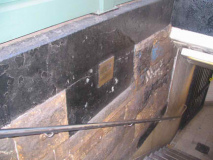
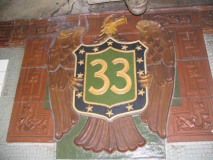
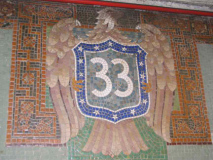

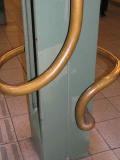

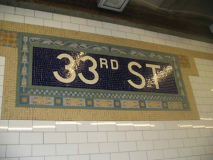
7 comments
[…] 1945年まで使われていたオリジナルのCity Hall Station 1904年開業時の最初の28駅の始発駅でもある […]
[…] Worth St became, well, worthless. However, the station’s name bears significant meaning as it was named after General William Jenkins Worth, a hero of the Mexican War in the 1840s. On a slow moving 6 train, the word “Worth” and […]
Right after the City deployed that reproduction kiosk at Astor Place, I happened upon the scene, and found four interesting souvenirs: four massive steel loopholes that held the kiosk in place on its delivery truck had been sliced off by saws or dismantling torches, and lay on the ground.
I scooped all four up, and took them home, intending to give them to pals. Nobody wanted them.
I wound up giving them to the New York Transit Museum, and while they were happy to get them, the curator who inherited them wasn’t sure what to do with them…he later told me at a Transit Museum event that one was serving as a paperweight on his desk.
I thumbed through a book I had with me on the subways, and showed him the name of the company that made the kiosk.
“They might be interested in getting one or two back for the guys who built it or designed it, maybe as the centerpiece of a presentation.”
His face brightened immediately. “I think I’ll do just that,” he said.
That was my good deed for thed ay.
[…] the station’s name bears significant meaning as it was named after General William Jenkins Worth, a hero of the Mexican War in the 1840s. On a slow moving 6 train, the word “Worth” and […]
“Eventually this notion was dropped — except at both the IND and 7th Avenue IRT 34th Street stations”
Actually, there’s a 3rd station that does this; Atlantic Avenue’s IRT station segregates the 7th Avenue and Lexington Avenue Trains in this manner, as the 7th Ave trains (2 & 3) run local in Brooklyn.
In my younger days I was fast enough to make it down the stairs and up the stairs to switch platforms (southbound) if the 5 to Flatbush showed up before the 2 did on the rare occasions I took one of the other lines or the LIRR to Atlantic.
The M train doesnt stop at canal st
Pelham Diesels Ed Brennan will always be the definition of a cock sucker! He did more to hurt the TA then anyone in his position at the time with Mike Lombardi and his cronies being a close second. Let those assholes forever rot in hell!!!